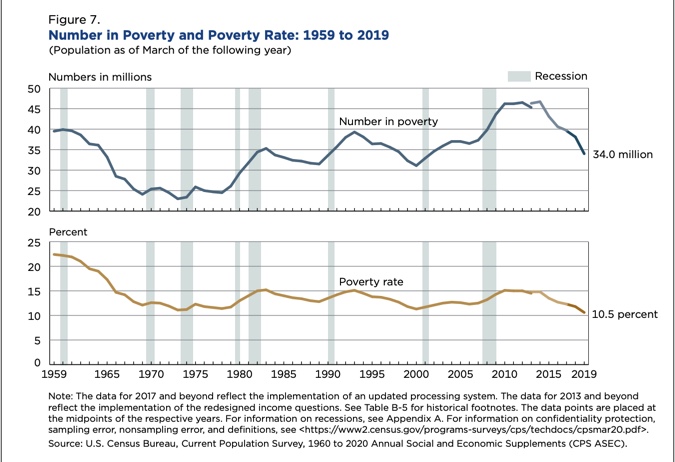Poverty was going down in the US before the pandemic
On September 15th, the US Census Bureau released its Income and Poverty in the United States Report. According to the 2019 numbers median income has risen in the US and poverty has fallen.
Median household income was $68,703 in 2019, an increase of 6.8% from the 2018 median. Between 2018 and 2019, the real median earnings of all workers increased by 1.4%, while the real median earnings of full-time, year-round workers increased 0.8%. The 2019 real median earnings of men and women who worked full-time, year-round increased by 2.1% and 3.0%, respectively, between 2018 and 2019. The difference between the 2018-2019 percent changes in median earnings for men and women working full-time, year-round was not statistically significant. The number of full-time, year-round workers increased by approximately 1.2 million between 2018 and 2019. Between 2018 and 2019, the total number of people with earnings increased by about 2.2 million.
The official poverty rate in 2019 was 10.5%, a decrease of 1.3 percentage points from 11.8% in 2018. This is the fifth consecutive annual decline in the national poverty rate. Since 2014, the poverty rate has fallen 4.3 percentage points, from 14.8% to 10.5%. The 2019 poverty rate of 10.5% is the lowest rate observed since estimates were initially published for 1959. The number of people in poverty in 2019 was 34.0 million, 4.2 million fewer people than 2018.

Poverty decline has been consistent across different demographics
Additionally, poverty decline trends have been consistent over demographic groups. Poverty decline has, additionally, been due to a strong economy that characterized the country before the coronavirus. As illustrated by the American Enterprise Institute (AEI)
Poverty declines in 2019 were consistent across demographic groups. Declines in the supplemental poverty measure (which incorporates government benefits into the poverty calculation) were statistically significant for people across racial and ethnic groups. They included a 2-percentage point decline among Blacks and a 2.2-percentage point decline among Asians. The declines were equally large when looking at the official poverty measure, which does not include government benefits such as food assistance and tax credits in the poverty calculation. Importantly, “the Black [official] poverty rate was the lowest since 1959, the first year for which poverty estimates were published.”
These historically low poverty rates are largely a product of the strength of the US economy before the pandemic hit, with an unemployment rate of 3.5 percent in December 2019 and 20-year unemployment rate lows for Black Americans and for men. Notwithstanding the problems that remain in our federal safety net, programs with a focus on connecting low-income Americans to work have successfully reduced poverty when paired with the strong US economy.
It is safe to say that the coronavirus pandemic might offset some of the gains that the country has made. But these numbers show just how beneficial a strong and growing economy is to the well-being of the people. Contrary to popular opinion, it is not just the rich that benefit from a growing economy. These numbers show that a strong economy benefits everyone and contributes a lot to uplifting people out of poverty.